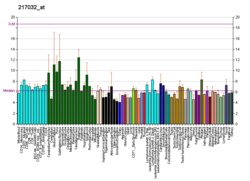FOXD4
Protein-coding gene in the species Homo sapiens
| FOXD4 | |||||||||||||||||||||||||||||||||||||||||||||||||||
|---|---|---|---|---|---|---|---|---|---|---|---|---|---|---|---|---|---|---|---|---|---|---|---|---|---|---|---|---|---|---|---|---|---|---|---|---|---|---|---|---|---|---|---|---|---|---|---|---|---|---|---|
| Identifiers | |||||||||||||||||||||||||||||||||||||||||||||||||||
| Aliases | FOXD4, FKHL9, FOXD4A, FREAC-5, FREAC5, forkhead box D4 | ||||||||||||||||||||||||||||||||||||||||||||||||||
| External IDs | OMIM: 601092; MGI: 1347467; HomoloGene: 83248; GeneCards: FOXD4; OMA:FOXD4 - orthologs | ||||||||||||||||||||||||||||||||||||||||||||||||||
| |||||||||||||||||||||||||||||||||||||||||||||||||||
| |||||||||||||||||||||||||||||||||||||||||||||||||||
| |||||||||||||||||||||||||||||||||||||||||||||||||||
| |||||||||||||||||||||||||||||||||||||||||||||||||||
| |||||||||||||||||||||||||||||||||||||||||||||||||||
| Wikidata | |||||||||||||||||||||||||||||||||||||||||||||||||||
| |||||||||||||||||||||||||||||||||||||||||||||||||||
Forkhead box protein D4 is a protein that in humans is encoded by the FOXD4 gene.[5][6][7][8]
References
- ^ a b c GRCh38: Ensembl release 89: ENSG00000170122 – Ensembl, May 2017
- ^ a b c GRCm38: Ensembl release 89: ENSMUSG00000051490 – Ensembl, May 2017
- ^ "Human PubMed Reference:". National Center for Biotechnology Information, U.S. National Library of Medicine.
- ^ "Mouse PubMed Reference:". National Center for Biotechnology Information, U.S. National Library of Medicine.
- ^ Pierrou S, Hellqvist M, Samuelsson L, Enerback S, Carlsson P (Dec 1994). "Cloning and characterization of seven human forkhead proteins: binding site specificity and DNA bending". EMBO J. 13 (20): 5002–12. doi:10.1002/j.1460-2075.1994.tb06827.x. PMC 395442. PMID 7957066.
- ^ Larsson C, Hellqvist M, Pierrou S, White I, Enerback S, Carlsson P (Feb 1997). "Chromosomal localization of six human forkhead genes, freac-1 (FKHL5), -3 (FKHL7), -4 (FKHL8), -5 (FKHL9), -6 (FKHL10), and -8 (FKHL12)". Genomics. 30 (3): 464–9. doi:10.1006/geno.1995.1266. PMID 8825632.
- ^ Freyaldenhoven BS, Fried C, Wielckens K (Sep 2002). "FOXD4a and FOXD4b, two new winged helix transcription factors, are expressed in human leukemia cell lines". Gene. 294 (1–2): 131–140. doi:10.1016/S0378-1119(02)00702-3. PMID 12234674.
- ^ "Entrez Gene: FOXD4 forkhead box D4".
Further reading
- Cederberg A, Betz R, Lagercrantz S, et al. (1997). "Chromosome localization, sequence analysis, and expression pattern identify FKHL 18 as a novel human forkhead gene". Genomics. 44 (3): 344–6. doi:10.1006/geno.1997.4864. PMID 9325056.
- Fan Y, Newman T, Linardopoulou E, Trask BJ (2003). "Gene content and function of the ancestral chromosome fusion site in human chromosome 2q13-2q14.1 and paralogous regions". Genome Res. 12 (11): 1663–72. doi:10.1101/gr.338402. PMC 187549. PMID 12421752.
- Strausberg RL, Feingold EA, Grouse LH, et al. (2003). "Generation and initial analysis of more than 15,000 full-length human and mouse cDNA sequences". Proc. Natl. Acad. Sci. U.S.A. 99 (26): 16899–903. Bibcode:2002PNAS...9916899M. doi:10.1073/pnas.242603899. PMC 139241. PMID 12477932.
- Humphray SJ, Oliver K, Hunt AR, et al. (2004). "DNA sequence and analysis of human chromosome 9". Nature. 429 (6990): 369–74. Bibcode:2004Natur.429..369H. doi:10.1038/nature02465. PMC 2734081. PMID 15164053.
- Gerhard DS, Wagner L, Feingold EA, et al. (2004). "The status, quality, and expansion of the NIH full-length cDNA project: the Mammalian Gene Collection (MGC)". Genome Res. 14 (10B): 2121–7. doi:10.1101/gr.2596504. PMC 528928. PMID 15489334.
- Minoretti P, Arra M, Emanuele E, et al. (2007). "A W148R mutation in the human FOXD4 gene segregating with dilated cardiomyopathy, obsessive-compulsive disorder, and suicidality". Int. J. Mol. Med. 19 (3): 369–72. doi:10.3892/ijmm.19.3.369. PMID 17273782.
- v
- t
- e
(1) Basic domains | |||||||||||||||||||||||||
|---|---|---|---|---|---|---|---|---|---|---|---|---|---|---|---|---|---|---|---|---|---|---|---|---|---|
| |||||||||||||||||||||||||
(2) Zinc finger DNA-binding domains | |||||||||||||||||||||||||||
|---|---|---|---|---|---|---|---|---|---|---|---|---|---|---|---|---|---|---|---|---|---|---|---|---|---|---|---|
| |||||||||||||||||||||||||||
(3) Helix-turn-helix domains | |||||||||||||||||||||
|---|---|---|---|---|---|---|---|---|---|---|---|---|---|---|---|---|---|---|---|---|---|
| |||||||||||||||||||||
(4) β-Scaffold factors with minor groove contacts | |||||||||||||||||||
|---|---|---|---|---|---|---|---|---|---|---|---|---|---|---|---|---|---|---|---|
| |||||||||||||||||||
(0) Other transcription factors | |||||||||
|---|---|---|---|---|---|---|---|---|---|
| |||||||||
see also transcription factor/coregulator deficiencies
 | This article on a gene on human chromosome 9 is a stub. You can help Wikipedia by expanding it. |
- v
- t
- e



















